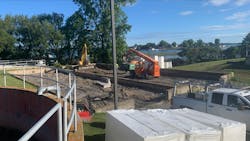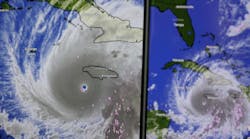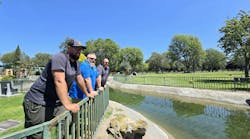NY begins $2.4M flood project
New York officials earlier this week announced the start of construction on a $2.4 million project awarded to the Village of Clayton, Jefferson County. The project addresses the damage sustained during high water events and will eliminate overflows to the St. Lawrence.
The funding was provided through the State's Resiliency and Economic Development Initiative (REDI). The flooding of the St. Lawrence River in 2019 negatively impacted the Village of Clayton Wastewater Collection System and Treatment Plant as well as the Riverside Drive and East Union Street Pump Stations, leaving portions of the infrastructure below water, limiting pumping capabilities and causing interruption of the disinfection process.
The Riverside Drive Pump Station wet well will be expanded and dry pit submersible pumps will be installed, with increased capacity in the dry well. Other mitigation measures for this project include converting the existing chlorine contact to an intermediate effluent lift station and expanding the filtration/disinfection building with larger filters and UV disinfection systems to treat the entire plant flow.
"The continued progress of the REDI program is a testament to what happens when state and local governments work together," Governor Hochul said. "Through these partnerships, we are working hand in hand to ensure local infrastructure is reimagined and redesigned."
Department of Environmental Conservation Commissioner Basil Seggos said, "High water has repeatedly damaged critical wastewater infrastructure along the shores of Lake Ontario and the St. Lawrence River. Today's announcement marks the start of construction on a project that will both repair damage that devastated the Village of Clayton's wastewater collection system in 2019, and improve its resiliency to withstand future flood events. Through sustained investments, New York's REDI program is building communities back better and stronger."
President and CEO, Environmental Facilities Corporation (EFC) Joseph Rabito said, "Working to eliminate overflows into the St. Lawrence River due to flooding, will help protect the health of the waterway and surrounding communities. By providing low-cost financing and grants to New York State municipalities in support of the REDI program, EFC can assist in the protection of critical infrastructure that contributes to the long-term resiliency of our shorelines."
In response to the extended pattern of flooding along the shores of Lake Ontario and the St. Lawrence River, REDI was created to increase the resilience of shoreline communities and bolster economic development in the region. Five REDI Regional Planning Committees, comprised of representatives from eight counties (Niagara and Orleans, Monroe, Wayne, Cayuga and Oswego, and Jefferson and St. Lawrence) were established to identify local priorities, at-risk infrastructure and other assets, and public safety concerns. The REDI Commission allocated $20 million for homeowner assistance, $30 million to improve the resiliency of businesses, and $15 million toward a regional dredging effort that will benefit each of the eight counties in the REDI regions. The remaining $235 million has been allocated towards local and regional projects that advance and exemplify the REDI mission.
SOURCE: New York State


